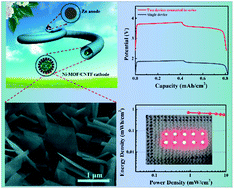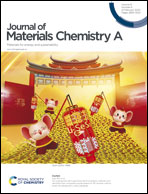Nickel metal–organic framework nanosheets as novel binder-free cathode for advanced fibrous aqueous rechargeable Ni–Zn battery†
Abstract
Metal–organic frameworks (MOFs) have been exploited as promising electroactive materials for application in electrochemical energy storage such as supercapacitors due to their versatility and high specific surface area. To date, with the massive demand for power sources for portable and wearable electronics, plentiful research has been dedicated to the development of fiber-shaped energy storage devices with miniaturization and appropriate wearability. However, the application of the benign and reliable Ni–Zn battery with high energy density is uncertain for portable and wearable electronic devices. In this study, Ni-MOF nanosheets with favorable electron conductivity and electrochemical performance were first established as a cathode for a flexible fiber aqueous rechargeable Ni–Zn battery. The assembled Ni–Zn battery delivered a high capacity of 0.4 mA h cm−2 and a high energy density of 0.71 mW h cm−2. Additionally, the resulting Ni–Zn battery offered excellent flexibility with a capacity retention of 91.2% after bending 100 times. Therefore, this work provides a proof-of-concept design for the application of pristine MOFs in wearable energy storage devices.



 Please wait while we load your content...
Please wait while we load your content...